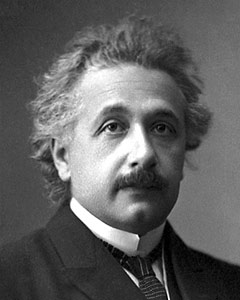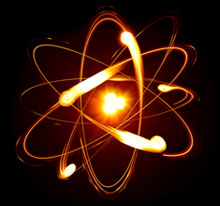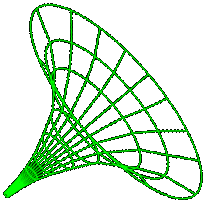
Albert Einstein
1879 - 1955
Formulated the theory of relativity which revolutionized modern astrophysics
Received the Nobel Prize in 1921 for his 1905 work on the photoelectric effect
Received the Copley Medal of the Royal Society in 1925 and the Gold Medal of the Royal Astronomical Society in 1926
Albert Einstein is perhaps one of the most well known faces in the field of physics and one of the most famous scientists of the twentieth century. He revolutionized scientific thinking and is acknowledged as the greatest theoretical physicist who ever lived. Einstein was born on March 14, 1879 to middle-class Jewish parents in Ulm, Germany. He disliked school and preferred to study at home. He never completed secondary school. His family moved to Milan in 1894, and at this time he decided to officially relinquish his German citizenship and become a citizen of Switzerland. In 1985 he attempted enter the Swiss Federal Institute of Technology (the Zurich Polytechnic), but he failed an entrance examination. At this time he decided to complete his secondary school education at the nearby Aarau at the cantonal secondary school. In 1896 he returned to Zurich Polytechnic, where he graduated (1900) as a secondary school teacher of mathematics and physics.

Einstein later obtained a job at the patent office in Bern, where he worked from 1902 to 1909. During this time he completed an amazing number of publications on theoretical physics. He wrote these in his spare time without the benefit of contact with scientific literature or colleagues. In his first of three papers, Einstein examined the phenomenon whereby electromagnetic energy seemed to be emitted from radiating objects in discrete quantities. Einstein used Planck's quantum hypothesis to describe the electromagnetic radiation of light. Einstein's second 1905 paper proposed what is today called the special theory of relativity. This new theory stated that the laws of physics had to have the same form in any frame of reference. The theory also stated that the speed of light remained constant in all frames of reference. Later in 1905 Einstein showed how mass and energy were equivalent. Einstein was not the first to propose all the components of special theory of relativity. His contribution was to unify important parts of classical mechanics and electrodynamics. His third paper covered statistical mechanics.
In 1905 Einstein submitted the first of his papers and earned a doctorate degree from the University of Zurich. In 1908 he became a lecturer at the University of Bern after sending them a second paper. The following year he received a regular appointment as associate professor of physics at the University of Zurich. By 1909 Einstein was recognized a one of the world's leading scientific thinkers. He later held professorships at the German University of Prague and at the Zurich Polytechnic. By 1911 Einstein was able to make preliminary predictions about how a ray of light from a distant star, passing near the Sun, would appear to be bent slightly, in the direction of the Sun. Around 1912, Einstein began a new phase of his gravitational research, with the help of his mathematician friend Marcel Grossmann. Einstein called his new work the general theory of relativity. After a number of false starts, he finally published the definitive version of general theory of relativity in 1915.

Einstein returned to Germany in 1914 but did not reapply for German citizenship. That year he advanced to his most prestigious post as professor at the Kaiser-Wilhelm Gesellschaft in Berlin. From this time forward he never again taught regular university courses. Einstein received the Nobel Prize in 1921 for his 1905 work on the photoelectric effect. He remained on the staff at Berlin until 1933. Later that year, with the rise of fascism in Germany, Einstein moved to the United States. In 1939 he sent a letter to President Franklin D. Roosevelt that urged that the United States proceed to develop an atomic bomb before Germany did. This letter, and many others after it, contributed to Roosevelt's decision to fund what became the Manhattan Project. The remainder of Einstein's life was spent holding a research position at the Institute for Advanced Study in Princeton, N.J. He spent his final years searching for a unified theory, whereby the phenomena of gravitation and electromagnetism could be derived from one set of equations. That search would be in vain. He died in 1955 without having found the elusive theory. Although his later thoughts were neglected for decades, physicists seek the same goal as Einstein's dream -- a grand unification of physical theory.




